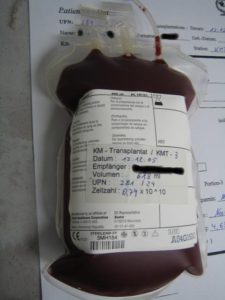
Recently Diagnosed or Relapsed? Stop Looking For a Miracle Cure, and Use Evidence-Based Therapies To Enhance Your Treatment and Prolong Your Remission
Multiple Myeloma an incurable disease, but I have spent the last 25 years in remission using a blend of conventional oncology and evidence-based nutrition, supplementation, and lifestyle therapies from peer-reviewed studies that your oncologist probably hasn't told you about.
Click the orange button to the right to learn more about what you can start doing today.
- You are here:
- Home »
- Blog »
- Multiple Myeloma »
- Blood Cancer Treatment- Autologous, Allogeneic, Sibling Cord Blood
Blood Cancer Treatment- Autologous, Allogeneic, Sibling Cord Blood

“Children needing a bone marrow transplant may find their best chance in umbilical cord blood from a sibling, even if the transplant is only partially matched to the recipient’s blood type…”
Blood cancers present a number of challenges not faced by patients and survivors of solid tumor cancers. Our primary challenge, of course, is that our cancer is systemic rather than local. Blood cancer patients can’t simply cut out their tumor. The equivalent of “cut out their tumor” is the Hematopoietic stem cell transplant commonly referred to as a bone marrow transplant (BMT).
Replacing the cancer patient’s bone marrow completely through an allogenaic BMT is risky yet can theoretically yield a cure. The two major challenges that come with an allo bmt are
- finding donor stem cells and
- the real risk of Graft v. Host Disease (GVHD)
According to the article linked and excerpted below the answer, in some cases, is for it to be umbilical cord blood from a sibling. If you are facing a possible BMT your challenge is to learn a great deal about this high risk/high reward procedure in a short amount of time.
Since my own autologous stem cell transplant in 12/95, I’ve studied both autologous as well as allogeneic stem cell transplants used for blood cancers. Newly diagnosed blood cancer patients must learn the risks and benefits of every available stem cell transplant before deciding on which BMT to undergo.
Make no mistake. Stem cell transplants are complicated, expensive procedures. In my experience, evidence-based non-conventional, complementary and integrative therapies must accompany stem cell transplantation to provide the best possible chance for the cancer patient.
I am both a multiple myeloma survivor and MM coach. I can help. Have you or a loved one been diagnosed with a blood cancer? What type? What stage? Please scroll down the page, post a question or comment and I will reply to you ASAP.
thank you
David Emerson
- MM Survivor
- MM Coach
- Director PeopleBeatingCancer
Recommended Reading:
- Enzyme alpha-1-antitrypsin May Reduce Graft-Vs.-Host Disease (GvHD)
- Meredith Cowden- Acute Myelogenous Leukemia
- Stem Cell Transplant for Blood Cancers- What you Need to Know
Hematopoietic stem cell transplantation
“Hematopoietic stem cell transplantation (HSCT) is the transplantation of multipotent hematopoietic stem cells, usually derived from bone marrow, peripheral blood, or umbilical cord blood.[1][2] It may be
- autologous (the patient’s own stem cells are used),
- allogeneic (the stem cells come from a donor) or
- syngeneic (from an identical twin).[1][2]
It is a medical procedure in the field of hematology, most often performed for patients with certain cancers of the blood or bone marrow, such as multiple myeloma or leukemia.[2] In these cases, the recipient’s immune system is usually destroyed with radiation or chemotherapy before the transplantation. Infection and graft-versus-host disease are major complications of allogeneic HSCT.[2]“
Sibling Cord Blood May Offer Best Match Chance For Some Patients
“Children needing a bone marrow transplant may find their best chance in umbilical cord blood from a sibling, even if the transplant is only partially matched to the recipient’s blood type, according to Duke researchers…
Researchers have found cord blood can restore bone marrow when the recipient/donor type match is not as close as that necessary in bone marrow transplants. A bone marrow transplant generally is successful only with a perfect match of all six antigens. Successful cord blood transplants from unrelated donors have been performed when only four of six antigens matched…
None of the patients who had half-match transplants from siblings had serious graft versus host disease. The transplants were successful in three of the four patients, who are alive and well 12 to 29 months after transplant…
The success offers hope for patients who otherwise may not find a suitable match for transplant, said Dr. Paul Martin of Duke’s pediatric bone marrow and cord blood transplant program. Three out of four siblings will be at least a 3/6, or half match for transplantation, he said.
“Harvesting a sibling’s blood may offer a curative therapy in three out of four cases,” he said.”


